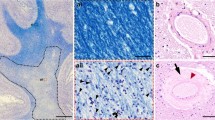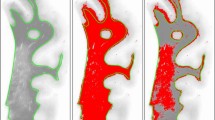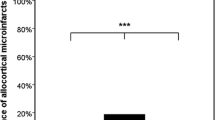Abstract.
Previous neuroimaging studies have indicated that corpus callosum atrophy in Alzheimer’s disease (AD) and large vessel occlusive disease (LVOD) is caused by interhemispheric disconnection, namely Wallerian degeneration of interhemispheric commissural nerve fibers originating from pyramidal neurons in the cerebral cortex. However, this hypothesis has not been tested from a neuropathological viewpoint. In the present study, 22 brains with AD (presenile onset, 9; senile onset, 13), 6 brains with Binswanger’s disease (BD), a form of vascular dementia and 3 brains with LVOD were compared with 6 non-neurological control brains.White matter lesions in the deep white matter and corpus callosum were quantified as a fiber density score by image analysis of myelin-stained sections. Axonal damage and astrogliosis were assessed by immunohistochemistry for amyloid precursor protein and glial fibrillary acidic protein, respectively.
The corpus callosum thickness at the anterior part of the body was decreased in AD and LVOD,but not in BD significantly, as compared with the controls. The corpus callosum thickness correlated roughly with brain weight in AD (R = 0.50),and with the severity of deep white matter lesions in BD (R = 0.81). Atrophy of the brain and corpus callosum was more marked in presenile onset AD than in senile onset AD. With immunohistochemistry, the corpus callosum showed axonal damage and gliosis with a decreased fiber density score in BD and LVOD, but not in AD. Thus, corpus callosum atrophy was correlated with brain atrophy in AD, which is relevant to the mechanism of interhemispheric disconnection,whereas corpus callosum lesions in BD were secondary to deep white matter lesions. Corpus callosum atrophy in LVOD may indicate interhemispheric disconnection, but focal ischemic injuries may also be involved.
Similar content being viewed by others
Author information
Authors and Affiliations
Corresponding author
Rights and permissions
About this article
Cite this article
Tomimoto, H., Lin, JX., Matsuo, A. et al. Different mechanisms of corpus callosum atrophy in Alzheimer’s disease and vascular dementia. J Neurol 251, 398–406 (2004). https://doi.org/10.1007/s00415-004-0330-6
Received:
Revised:
Accepted:
Issue Date:
DOI: https://doi.org/10.1007/s00415-004-0330-6




